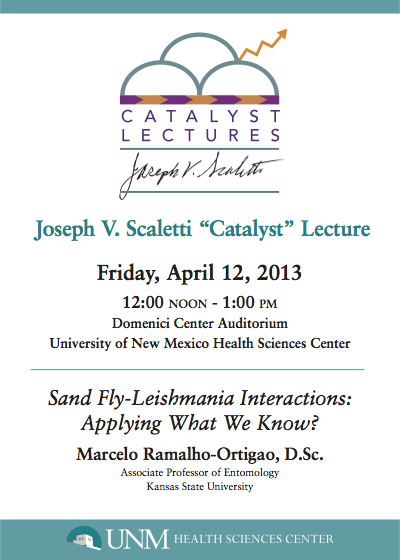 Sand Fly-Leishmania Interactions: Applying what we know
Sand Fly-Leishmania Interactions: Applying what we know
Entomologist/molecular biologist Marcelo Ramalho-Ortigao takes a comprehensive approach to Leishmaniasis, integrating research at the molecular level, with research on the responses of individual vertebrates to the disease, and extending into biogeographic studies of how land-use policies may affect the spread of disease, with the ultimate goal of furthering our understanding of the vector-pathogen interaction in general.
Leishmaniasis is a disease caused by the parasitic protozoan Leishmania and is transmitted by the bite of the female sandfly. The disease takes two forms, Cutaneous leishmanaisis which affects the skin and mucous membranes and, more severely, Visceral leishmanaisis in which the parasites migrate to the vital organs.
As principal investigator in the Department of Entomology’s Biology of Disease Vectors Laboratory at Kansas State University, Dr Marcelo Ramalho-Ortigao’s research focuses on the primary vector for this disease: the sand fly. He has demonstrated that, by targeting vector molecules, he can interfere with pathogen development within the vector, opening some new avenues for exciting future discoveries.

Dr Ramalho-Ortigao (center) in his lab: From L to R 1st row Nathan Elliott (MS student, summer NIH-ARRA intern), Dr. Ortigao, Dr. Narinder Sharma (posdoc), Iliano Coutinho-Abreu (PhD candidate); 2nd row Emma Hayes (MS student, summer NIH-ARRA intern), Maricela Robles-Murguia (Lab tech). Two students are not pictured: Leah Cox (MS student), and Shawna (undergrad). Photo from Biotekchina.com.cn
It’s this potential for Dr Ramalho-Ortigao’s approach to catalyze new research discoveries related to the prevention and treatment of this neglected tropical disease, that resulted in an invitation to present this year’s Joseph V. Scaletti Catalyst Lecture. Each year, the Catalyst Lecture features an individual, institution, or idea responsible for accelerating the rate of positive change and forward progress in the areas of biomedical research, healthcare education, or healthcare delivery. The lecture series honors the work and ideals of one of the founders of the UNM School of Medicine, microbiologist Dr Joseph V Scaletti.
Scheduled for 12 noon on April 12, 2013, Dr Ramalho-Ortigao’s talk, Sand Fly-Leishmania Interactions: Applying What We Know will cover various aspects of molecular interactions of the sand fly and Leishmania – focusing on the midgut of the vector, including details of midgut targets that might be used in prevention of disease transmission by sand flies, as well as basic biological functions of the disease.
 Friday, April 12, 2013
12:00 pm – 1:00 pm
Domenici Center Auditorium
University of New Mexico Health Sciences Center
Â
Friday, April 12, 2013
12:00 pm – 1:00 pm
Domenici Center Auditorium
University of New Mexico Health Sciences Center
Â